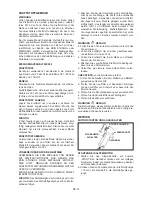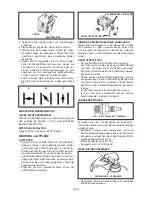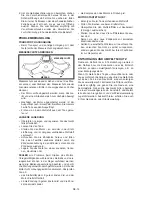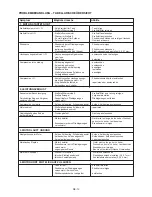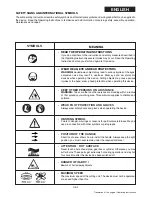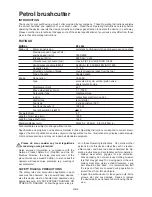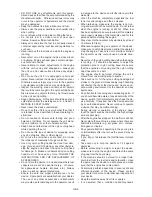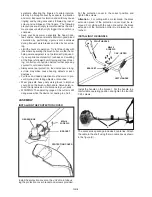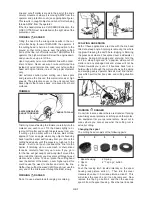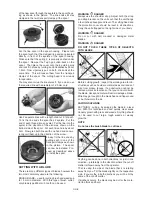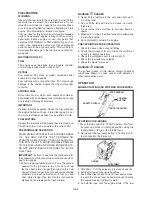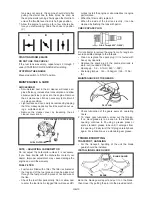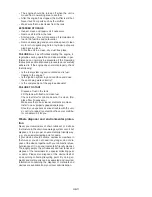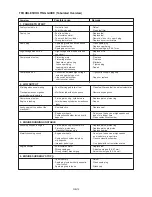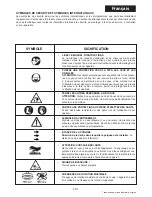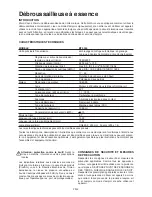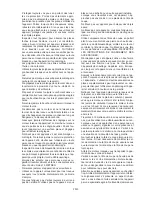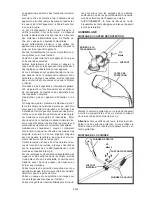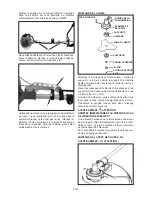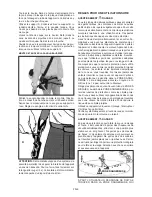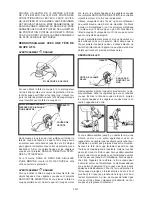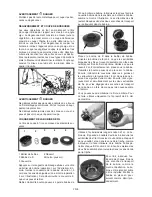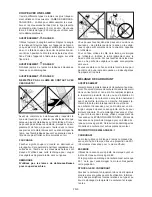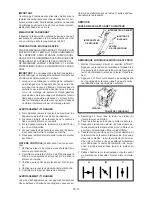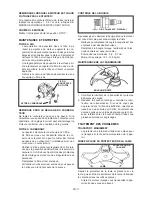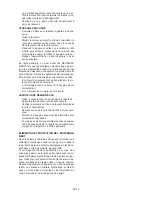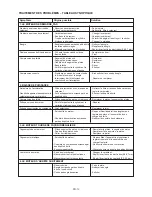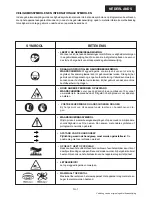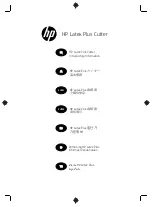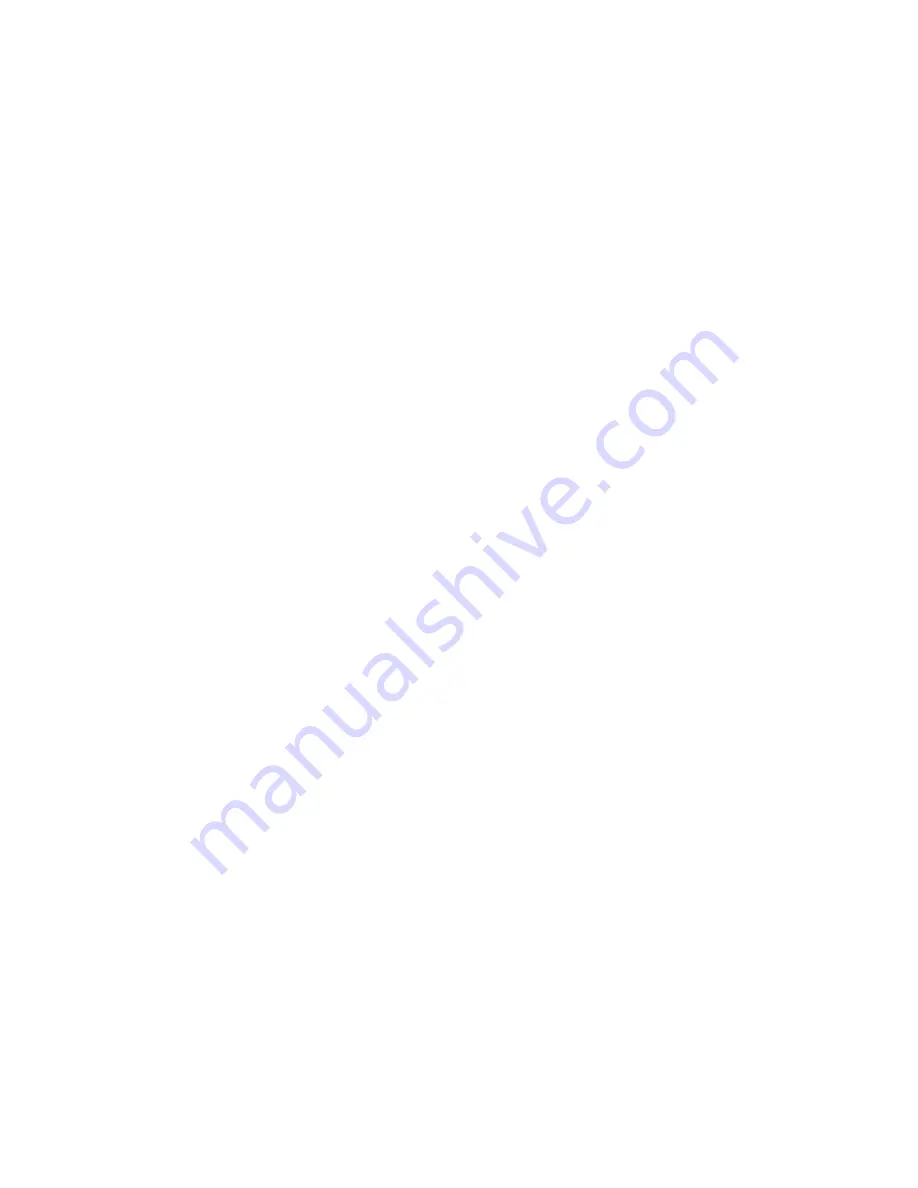
GB-11
• The engine should be turned off when the unit is
moved from on working area to another.
• After the engine has stopped, the muffler is still hot.
Never touch hot parts such as the muffler.
• Make sure that no fuel leaks from the tank.
EXTENDED STORAGE
• Inspect, clean and repair unit if necessary.
• Remove all fuel from the tank.
• Start engine – this will consume all remainders of
fuel in the fuel line and carburettor.
• Remove spark plug and pour one tea spoon of clean
motor oil into spark plug hole of cylinder; put spark
plug back in place.
• Store the unit in a clean, dry, dust-free place.
FAILURES
such as difficulties starting the engine, ir-
regularities during operation and abnormalities in per-
formance can normally be prevented if the Operating
Instructions and maintenance procedures are carefully
adhered to. If the engine does not work properly, check
the following:
• Is the fuel system in good condition and is fuel
flowing to the engine?
• Is the ignition system in good condition and does
the spark plug work correctly?
• Is the compression of the engine adequate?
FAILURE TO START
· Dispose of fuel in the tank.
· Fill the tank with fresh and clean fuel.
· Check fuel filter for dirt; make sure it is clean. (Re-
place filter if necessary.)
· Make sure that all air cleaner elements are clean.
· Install a new, properly gapped spark plug.
· Should you experience serious trouble with the unit,
do not try to repair it yourself, but have your distribu-
tor or dealer do it for you.
Waste disposal and environmental protec-
tion
Never pour remainders of chain lubricant or 2-stroke
fuel mixture in the drain or sewerage system or soil, but
dispose of it in a proper, environmentally friendly way,
e.g., at a special collecting point or dump.
If your device should become useless somewhere in
the future or you do not need it any longer, do not dis-
pose of the device together with your domestic refuse,
but dispose of it in an environmentally friendly manner.
Thoroughly empty the oil/lubricant and fuel tanks and
dispose of the remainders at a special collecting point
or dump. Please also dispose of the device itself at
an according collecting/recycling point. By doing so,
plastic and metal parts can be separated and recycled.
Information concerning the disposal of materials and
devices are available from your local administration.
Summary of Contents for BT 4344
Page 2: ......
Page 94: ...GR 1 15 ELLHNIKA...
Page 96: ...15 15 GR 3...
Page 97: ...Raynaud GR 4...
Page 98: ...M5xl6 M5x20 M5x25 X 2 X 2 1 1 2 2 2x16 3 A B GR 5...
Page 99: ...A 3 B A S 4 mm 2x16 A B x x GR 6...
Page 100: ...15 16 15 METERS 50 FEET 15 GR 7...
Page 101: ...Monofil 2 5 mm KNIFE SIDE RAISED ANGLE TO GROUND ANGLE TO WALL 2 3 4 5 1 1 2 3 4 5 GR 8...
Page 102: ...1 2 1 5 cm 5 4 3 1 2 2 4 1 5 cm 2 5 mm 2 2 1 m 2 2 cm 15mm 3 255 mm GR 9...
Page 103: ...89 30 1 2 2 30 1 89 30 1 2 30 1 1 2 3 4 3 4 GR 10...
Page 104: ...5 6 1 2 3 4 5 STOPP l Stopp START 2 7 10 CHOKE 3 A 4 5 B 6 7 C A B C 3 7 Stopp STOP GR 11...
Page 105: ...O 6 0 7mm 0 023 O 028 0 6 0 7 mm 145 155 kg cm 1 25 2 GR 12...
Page 106: ...2 GR 13...
Page 107: ...1 0 6 0 7 mm Stop 2 3 0 6 0 7 mm 0 3 0 4 mm 4 GR 14...
Page 108: ......
Page 114: ......
Page 119: ......

